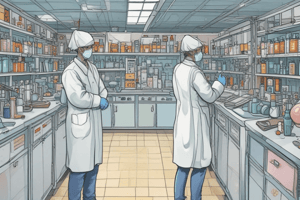Podcast
Questions and Answers
What is the primary goal of biosafety in a microbiology laboratory?
What is the primary goal of biosafety in a microbiology laboratory?
- To only implement safety protocols for chemical hazards
- To reduce the risk of exposure to potentially infectious microorganisms and limit contamination of the work environment and the community (correct)
- To completely eliminate all risks in the laboratory
- To solely focus on proper specimen collection and handling
What type of laboratory is equipped with sophisticated diagnostic and investigative facilities?
What type of laboratory is equipped with sophisticated diagnostic and investigative facilities?
- Secondary level laboratory
- Primary level laboratory
- Tertiary level laboratory (correct)
- Reference laboratory
What is the main difference between safety and risk deletion?
What is the main difference between safety and risk deletion?
- Safety is the absence of risks, while risk deletion is the elimination of risks
- There is no difference between safety and risk deletion
- Safety is the elimination of risks, while risk deletion is the management of risks
- Safety is the management of risks, while risk deletion is the absence of risks (correct)
What is a common risk in a clinical laboratory?
What is a common risk in a clinical laboratory?
What is the purpose of a reference laboratory?
What is the purpose of a reference laboratory?
How many biosafety levels are there?
How many biosafety levels are there?
What determines the level of containment in a microbiology laboratory?
What determines the level of containment in a microbiology laboratory?
What is the purpose of routine decontamination of work surfaces in a microbiology laboratory?
What is the purpose of routine decontamination of work surfaces in a microbiology laboratory?
What is the primary factor that determines the Biological Safety Level (BSL) required for a microbiology laboratory?
What is the primary factor that determines the Biological Safety Level (BSL) required for a microbiology laboratory?
What is a characteristic of a microbe classified as Risk Group 1 (RG-1)?
What is a characteristic of a microbe classified as Risk Group 1 (RG-1)?
What is a common practice followed in all microbiology laboratories, regardless of biosafety level?
What is a common practice followed in all microbiology laboratories, regardless of biosafety level?
What is the biosafety level of a laboratory where nonpathogenic strains of E. are typically worked with?
What is the biosafety level of a laboratory where nonpathogenic strains of E. are typically worked with?
What is a characteristic of microbes handled in a BSL-4 laboratory?
What is a characteristic of microbes handled in a BSL-4 laboratory?
What is a requirement for laboratory practices in a BSL-4 laboratory?
What is a requirement for laboratory practices in a BSL-4 laboratory?
What is the primary function of a Biological Safety Cabinet (BSC)?
What is the primary function of a Biological Safety Cabinet (BSC)?
What is a feature of a Class II or Class III Biological Safety Cabinet?
What is a feature of a Class II or Class III Biological Safety Cabinet?
What is a requirement for BSL-4 facility construction?
What is a requirement for BSL-4 facility construction?
What is the purpose of a HEPA filter in a Biological Safety Cabinet?
What is the purpose of a HEPA filter in a Biological Safety Cabinet?
Flashcards are hidden until you start studying




